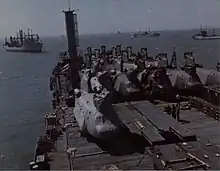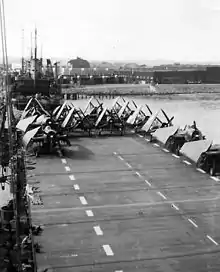USS Point Cruz
USS Point Cruz (CVE-119) was a Commencement Bay-class escort carrier of the United States Navy. Originally named Trocadero Bay until 5 June 1944 when it was renamed after the Honiara suburb Point Cruz, which was an important location during the Guadalcanal Campaign. She was laid down on 4 December 1944 by Todd Pacific Shipyards Incorporated, Tacoma, Washington; launched on 18 May 1945, sponsored by Mrs. Earl R. DeLong; and commissioned on 16 October 1945.
_underway_on_25_June_1955_(NNAM.1996.488.035.047).jpg.webp) USS Point Cruz (CVE-119), 25 June 1955 | |
| History | |
|---|---|
| Name | USS Point Cruz |
| Builder | Todd Pacific Shipyards |
| Laid down | 4 December 1944 |
| Launched | 18 May 1945 |
| Commissioned | 16 October 1945 |
| Decommissioned | 30 June 1947 |
| Recommissioned | 26 July 1951 |
| Decommissioned | 31 August 1956 |
| Reclassified | Cargo Ship and Aircraft Ferry, AKV-19, 17 May 1957 |
| In service | 23 August 1965 |
| Out of service | 16 October 1969 |
| Reclassified | T-AKV-19, August 1965 |
| Stricken | 15 September 1970 |
| Fate | Sold and scrapped in 1971 |
| General characteristics | |
| Class and type | Commencement Bay-class escort carrier |
| Displacement | 10,900 long tons (11,100 t)[1] |
| Length | 557 ft (170 m) |
| Beam | 75 ft (23 m) |
| Draft | 32 ft (9.8 m) |
| Propulsion | 2-shaft geared turbines, 16,000 shp |
| Speed | 19 knots (22 mph; 35 km/h) |
| Complement | 1,066 officers and men |
| Armament |
|
| Aircraft carried | 34 |
| Service record | |
| Part of: |
|
| Operations: | |
Operational history

Following acceptance and shakedown, she conducted pilot qualifications off the West Coast from October 1945 to March 1946. Thereafter she ferried aircraft to forward bases in WestPac. She entered Puget Sound Naval Shipyard on 3 March 1947 for inactivation; was decommissioned on 30 June 1947 and entered the Pacific Reserve Fleet, Bremerton, Washington.
After the start of hostilities in Korea the ship was activated and recommissioned on 26 July 1951. Point Cruz departed Bremerton on 4 January 1953 after coastal operations and an extensive overhaul modifying her for use as an anti-submarine warfare Hunter-Killer Group carrier. During the transit to San Diego, Point Cruz was damaged in a severe Pacific storm and repairs required several months.
Based at Sasebo, Japan, Point Cruz patrolled the Korean coast in the spring of 1953.(Captain John T. Hayward took command in July 1953.) After the armistice, she served as base for a helicopter squadron that took part in "Operation Platform", airlifting Indian troops to the Panmunjom buffer zone to supervise the prisoner of war exchange.
The CVE returned to San Diego in late December 1953, and after training and additional overhaul deployed to WestPac again in April 1954, under the command of Captain John T. Hayward. In the Far East the carrier served as command ship for Carrier Division 17.
The ship returned to San Diego in November 1954, and deployed again on 24 August 1955. While in the Pacific operating with the 7th Fleet, she served as flagship of Carrier Division 15. Point Cruz departed Yokosuka on 31 January 1956 and arrived at Long Beach, California, in early February for inactivation at Puget Sound Naval Shipyard. Decommissioned on 31 August 1956, CVE-119 was placed in the Bremerton Group of the Pacific Reserve Fleet. While in a reserve status, she was redesignated an aircraft transport, AKV-19, on 17 May 1957.
Point Cruz was reactivated on 23 August 1965 and placed under the operational control of the Military Sea Transportation Service (MSTS) as USNS Point Cruz (T-AKV-19) in September 1965. Commencing service as an aircraft ferry for MSTS, Point Cruz provided logistical support for American forces in South East Asia.
Decommissioning
She was placed out of service on 16 October 1969, struck from the Navy list on 15 September 1970, and sold for scrap in 1971.[2]
References
- Silverstone, Paul H. (1965). US Warships of World War 2. USA: Naval Institute Press. p. 444. ISBN 0-87021-773-9.
- "USS Point Cruz (CVE 119) of the US Navy - American Escort carrier of the Commencement Bay class - Allied Warships of WWII - uboat.net".
This article incorporates text from the public domain Dictionary of American Naval Fighting Ships.
